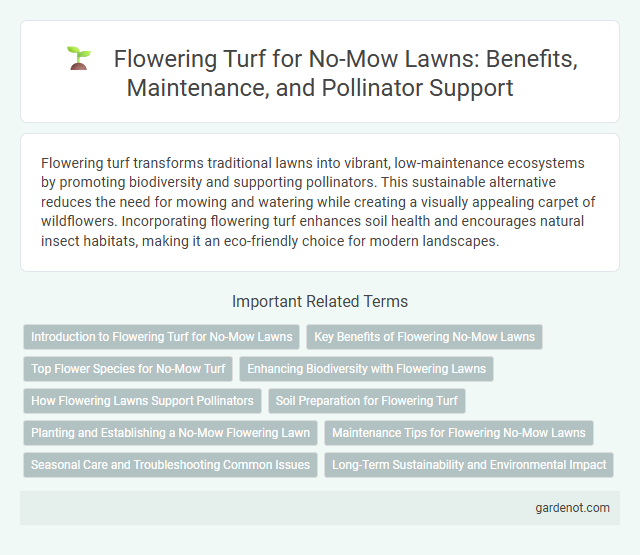Flowering turf transforms traditional lawns into vibrant, low-maintenance ecosystems by promoting biodiversity and supporting pollinators. This sustainable alternative reduces the need for mowing and watering while creating a visually appealing carpet of wildflowers. Incorporating flowering turf enhances soil health and encourages natural insect habitats, making it an eco-friendly choice for modern landscapes.
Introduction to Flowering Turf for No-Mow Lawns
Flowering turf integrates low-growing, diverse wildflowers and native grasses that thrive with minimal mowing, creating vibrant, eco-friendly landscapes. This sustainable approach enhances pollinator habitats, improves soil health, and reduces water usage compared to traditional lawn grasses. Popular species include creeping thyme, clover, and chamomile, which offer colorful blooms and resilience in no-mow lawn designs.
Key Benefits of Flowering No-Mow Lawns
Flowering no-mow lawns enhance biodiversity by providing essential habitats for pollinators like bees and butterflies, contributing to a healthier ecosystem. These lawns reduce maintenance time and water usage, leading to cost savings and environmental sustainability. The diverse floral species improve soil health and offer year-round visual appeal with vibrant blooms and varied textures.
Top Flower Species for No-Mow Turf
Top flower species for no-mow turf include white clover (Trifolium repens), which enhances soil nitrogen and attracts pollinators, and creeping thyme (Thymus serpyllum), valued for its drought tolerance and fragrant blooms. Other popular choices are self-heal (Prunella vulgaris) and wild chamomile (Matricaria chamomilla), both providing vibrant color and low maintenance requirements. These species create a resilient, eco-friendly lawn that supports biodiversity while reducing mowing frequency.
Enhancing Biodiversity with Flowering Lawns
Flowering turf transforms traditional lawns into vibrant ecosystems by integrating diverse native wildflowers that provide nectar and habitat for pollinators such as bees and butterflies. This approach enhances biodiversity, improves soil health, and supports local wildlife, creating sustainable green spaces with minimal mowing requirements. Adopting flowering lawns contributes to ecological balance and promotes a resilient urban environment.
How Flowering Lawns Support Pollinators
Flowering lawns provide essential habitats by offering diverse nectar and pollen sources for bees, butterflies, and other pollinators throughout the growing season. Compared to traditional grass-only lawns, flowering turf supports higher biodiversity and promotes healthier ecosystems by attracting beneficial insects. This natural pollinator support enhances plant fertilization and contributes to the sustainability of local flora and food crops.
Soil Preparation for Flowering Turf
Soil preparation for flowering turf requires thorough loosening and aeration to enhance root penetration and nutrient absorption. Incorporating organic matter like compost improves soil structure, moisture retention, and microbial activity essential for resilient flowering grasses. Conducting a soil test identifies nutrient deficiencies and pH imbalances, allowing for precise amendment with lime or fertilizer to optimize growth conditions.
Planting and Establishing a No-Mow Flowering Lawn
Planting a no-mow flowering lawn involves selecting native wildflower seeds and drought-tolerant grasses tailored to regional climate zones to ensure resilience and low maintenance. Establishing the lawn requires soil preparation through aeration and minimal fertilization, followed by even seed distribution and light rolling to enhance seed-to-soil contact for optimal germination. Regular monitoring during the first growing season helps manage weeds naturally, while eliminating mowing encourages deeper root growth and extended flowering periods, promoting biodiversity and ecosystem health.
Maintenance Tips for Flowering No-Mow Lawns
Flowering no-mow lawns require minimal maintenance but benefit from seasonal pruning to encourage healthy blooms and prevent overcrowding. Regular monitoring for weeds and removing invasive species early supports the vibrant growth of native flowering plants. Maintaining soil health through occasional aeration and organic mulching enhances nutrient availability, promoting a lush, colorful turf year-round.
Seasonal Care and Troubleshooting Common Issues
Flowering turf thrives with minimal mowing, benefiting from seasonal care such as early spring aeration and the application of organic mulch to enhance soil nutrients. Common issues include weed invasion and patchy growth, which can be managed through selective hand-weeding and overseeding with native wildflower seeds. Proper irrigation during dry spells and avoiding excessive fertilization promote a resilient, vibrant no-mow lawn throughout all seasons.
Long-Term Sustainability and Environmental Impact
Flowering turf enhances long-term sustainability by promoting biodiversity, supporting pollinators like bees and butterflies, and reducing the need for chemical fertilizers and pesticides. Its deep-rooted plants improve soil health, increase water retention, and reduce erosion compared to traditional lawns. This eco-friendly alternative lowers carbon emissions by minimizing lawn mower use and decreasing synthetic input reliance, contributing to a healthier environment.
Flowering turf Infographic

 gardenot.com
gardenot.com